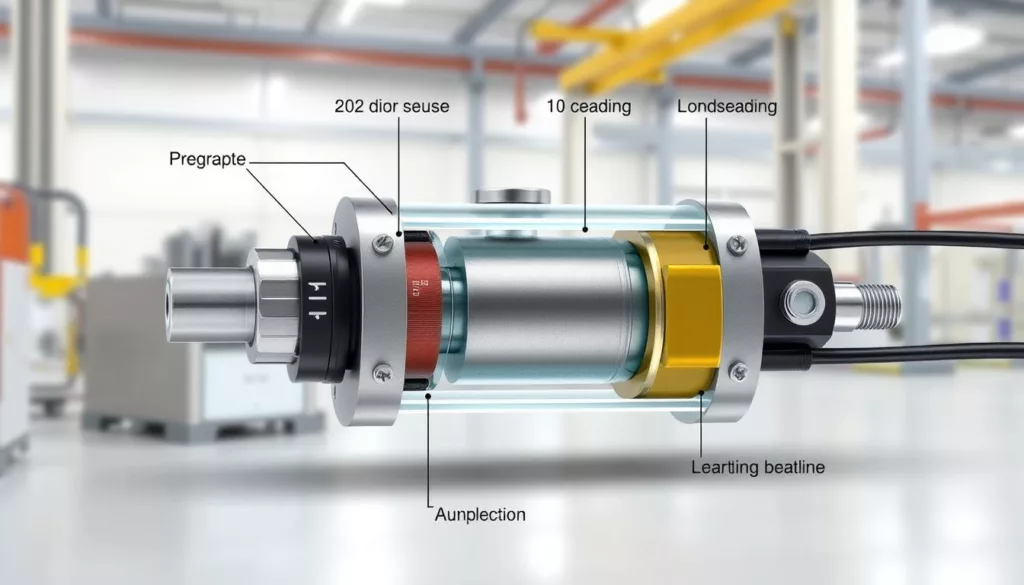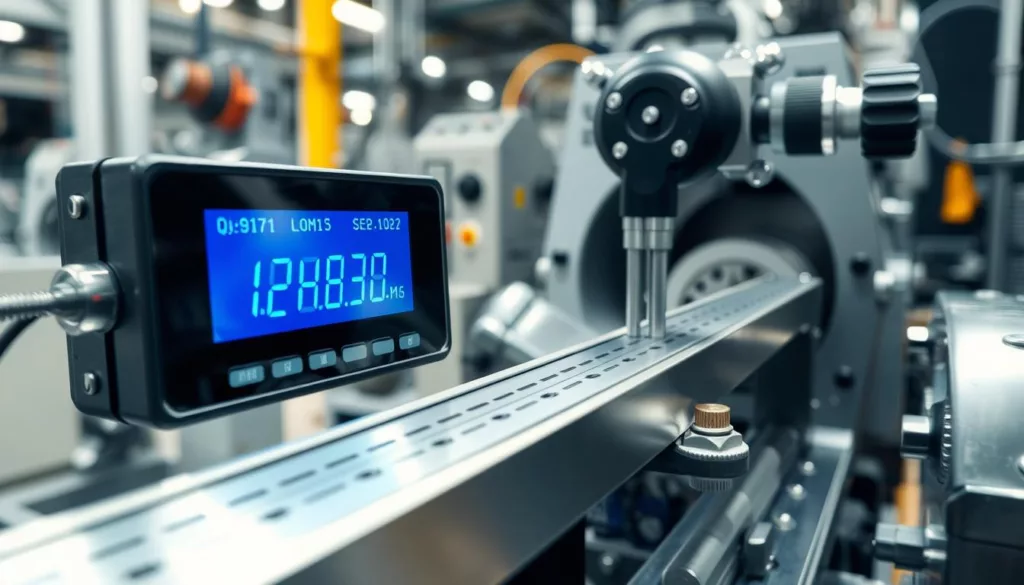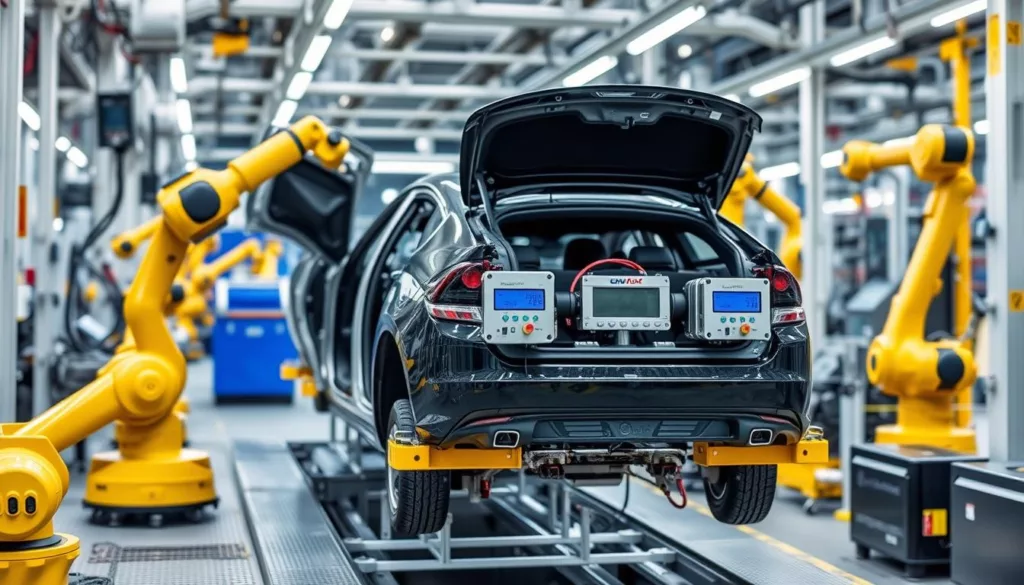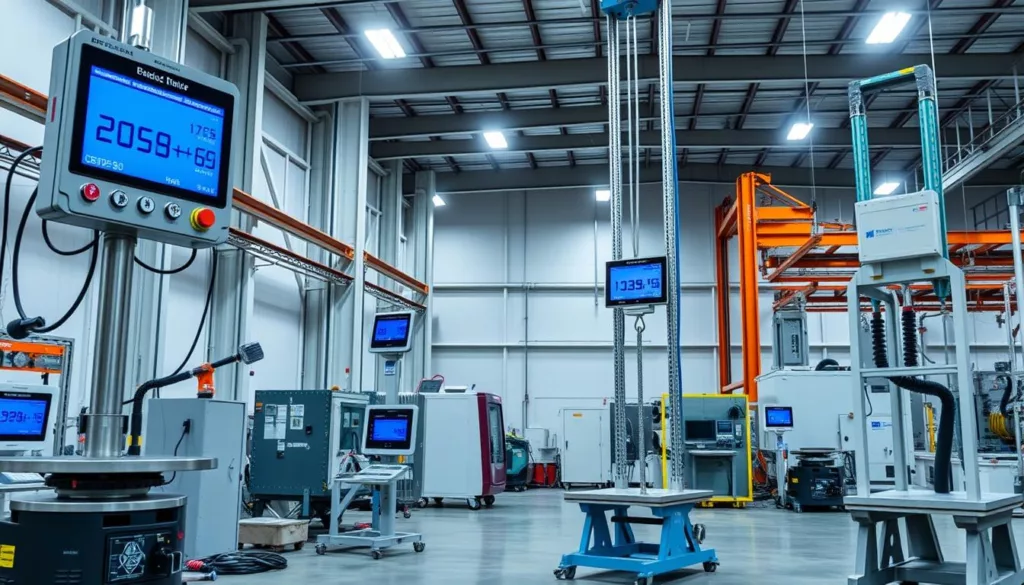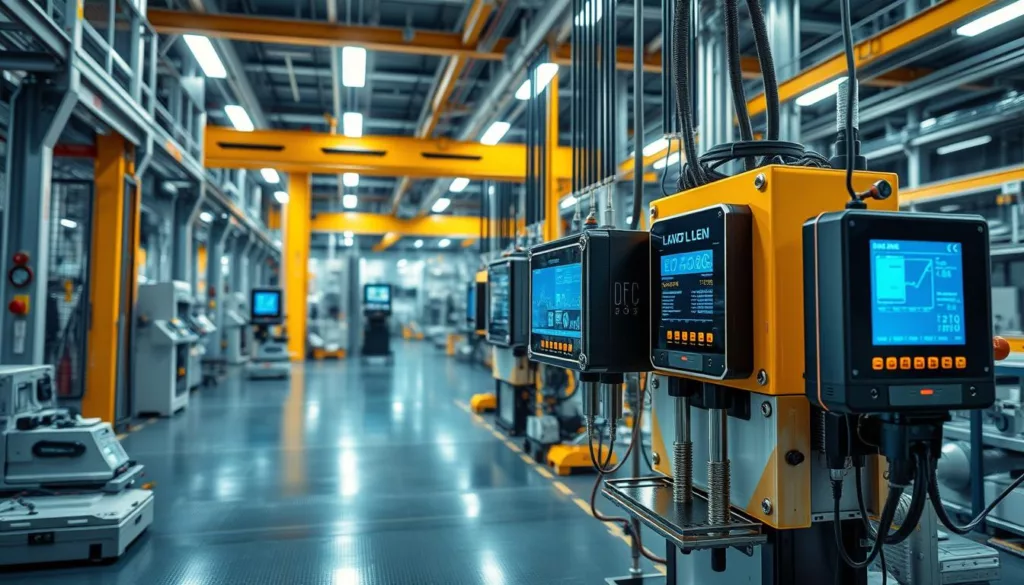In today’s fast-paced manufacturing world, load cells are vital. They measure force, weight, and more with great accuracy. Knowing how they work is key for better quality, efficiency, and safety.
Load cells are used in many areas, like material handling and quality checks. They help manufacturers make better choices and improve their work. This leads to higher quality and safer products.
This article will dive into how load cells work. We’ll look at their main functions, the different types, and their big impact on manufacturing. By grasping load cell technology, manufacturers can reach new heights in precision and success.
Key Takeaways
- Load cells are essential instruments in modern manufacturing, enabling precise measurement of force, weight, and other critical parameters.
- Manufacturers rely on load cells to enhance quality, optimize production, and ensure safety across a wide range of industrial processes.
- Understanding the principles and applications of load cell technology is vital for manufacturers to unlock new levels of precision, productivity, and profitability.
- The article will explore the key functions, types, and vital role of load cells in shaping modern manufacturing practices.
- Mastering load cell operation empowers manufacturers to make informed decisions, enhance efficiency, and maintain the highest standards of product quality and safety.
Introduction to Load Cells in Industrial Settings
In the world of industrial manufacturing, load cells are key. They ensure precision, efficiency, and safety. These devices are vital for force measurement applications, helping to monitor weight and pressure accurately.
Definition and Function
A load cell is a device that turns force or weight into an electrical signal. This signal is then used by electronic systems. It helps with process control, quality checks, and safety. Load cells measure different forces like compression and tension, making them critical in industrial weighing systems.
Importance in Manufacturing
In manufacturing, load cells are essential. They help keep quality, efficiency, and safety high. They track the weight of materials, work-in-progress, and finished products. This ensures accurate inventory management and meets industry standards.
Load cells also help in monitoring processes. They allow for real-time adjustments to machinery and production lines. This improves load cell construction and performance.
By giving accurate force and weight data, load cells help spot issues early. This prevents costly mistakes and keeps product quality consistent. It boosts productivity, cuts down on waste, and keeps workers and users safe.
“Load cells are the foundation of precise, reliable industrial weighing systems, empowering manufacturers to make data-driven decisions and optimize their operations.”
Types of Load Cells Used in Industry
In the world of manufacturing and material handling, load cells are key. They measure force and weight precisely. There are different types, each for specific uses. Let’s look at the three main types used across various sectors.
Strain Gauge Load Cells
Strain gauge load cells are the most common in industries. They work by measuring strain to turn force into an electrical signal. Known for their accuracy and cost, they’re used in many load cell sensing principles and material handling equipment tasks.
Hydraulic Load Cells
Hydraulic load cells measure force by moving fluid, like oil or water. They’re great for tough environments with high temperatures, vibrations, or hazards. Hydraulic load cells are often used in heavy-duty tasks, like crane scales or bulk material weighing.
Pneumatic Load Cells
Pneumatic load cells measure force by compressing air. They’re safe in places where electricity is a risk, like explosive atmospheres. You’ll find them in gas and oil pipelines, where they’re key for monitoring pressure and flow.
Each load cell type has its own benefits and fits specific needs. Knowing about load cell sensing principles and their features helps manufacturers choose the right one. This ensures accurate and reliable force and weight measurements for their material handling equipment and other needs.
How Load Cells Measure Force and Weight
Understanding how load cells work is key for precise force and weight measurements in industries. At the heart of a load cell’s function is strain measurement.
The Principle of Strain Measurement
Load cells change mechanical force or weight into an electrical signal. They use strain gauges attached to their structure. When a force is applied, the structure deforms slightly.
The strain gauges then detect these changes and turn them into an electrical signal. This allows for exact measurement of the applied force or weight.
Load Cell Calibration
Accurate load cell calibration is vital for reliable force and weight measurements. Calibration compares the load cell’s output to a known standard. This creates a precise link between the applied force or weight and the electrical signal.
| Calibration Method | Description |
|---|---|
| Deadweight Calibration | Uses precision weights to apply a known force to the load cell. This helps find the cell’s sensitivity and linearity. |
| Compression Testing | Tests the load cell’s response to compressive forces. It checks its ability to accurately detect weight or pressure changes. |
| Tension Testing | Looks at the load cell’s performance under tensile forces. It makes sure it works well for pull or lift measurements. |
Following strict calibration methods ensures load cell systems work well over time. This boosts the performance of process monitoring solutions.
Applications of Load Cells in Different Industries
Load cells are used in many industries. They help in material handling, logistics, food processing, and car making. These devices are key to improving efficiency and quality.
Material Handling and Logistics
In material handling and logistics, load cells are used in automated systems and warehouses. They give accurate weight readings. This helps manage loads better and makes workflows more efficient.
Companies use load cells to improve their automated production lines. They also help in keeping product quality high by using strong quality control mechanisms.
Food Processing
In food processing, load cells are vital for quality and consistency. They are found in packaging and filling machines, and in systems for weighing food. Load cells help keep recipes and portions exact, which is key for quality.
Automotive Manufacturing
The car industry depends on load cells for quality and efficiency. They are used in assembly lines, testing, and weighing vehicles. Load cells check component weights in real time, ensuring they meet standards.
This helps car makers improve their automated production lines. It also helps them use strong quality control mechanisms. This makes cars safer and more reliable.
“Load cells are the backbone of modern manufacturing, enabling precise measurement and control across a wide range of industries.”
Benefits of Using Load Cells
Load cells in industrial weighing systems and process monitoring solutions bring many benefits. They make operations more efficient and cost-effective. Load cells are key in various industries, improving accuracy, precision, and productivity.
Accuracy and Precision
Load cells measure force and weight accurately and precisely. This ensures reliable data for industrial use. Their advanced technology tracks weight changes, helping manufacturers make better decisions and control their processes well.
Enhanced Productivity
- Load cells streamline material handling and logistics, improving inventory management and workflow.
- They accurately track the weight of materials, helping control processes and reduce downtime.
- Accurate weight data from load cells ensures proper load distribution, boosting industrial system productivity.
Cost-Effectiveness
Using load cells in industrial systems can save a lot of money. They help avoid waste and optimize resource use. This makes production more cost-effective and efficient.
“Load cells are the backbone of industrial weighing systems, delivering the precision and reliability that modern manufacturing requires.”
Load cell technology helps industrial organizations improve accuracy, productivity, and cost-effectiveness. This positions them for success in the competitive manufacturing world.
Challenges in Load Cell Implementation
Load cells and force sensors are key in today’s industries. Yet, they face challenges like environmental factors and calibration issues. These can affect their accuracy and reliability.
Environmental Factors
Industrial settings can be tough, with extreme temperatures and vibrations. Load cell calibration and protection from the environment are vital. It’s important to choose load cells that can handle the facility’s conditions, like chemicals or moisture.
Calibration Difficulties
Keeping load cells calibrated is a big task. They need regular checks to stay accurate. This requires special tools, knowledge, and a commitment to upkeep.
| Environmental Factor | Impact on Load Cells | Mitigation Strategies |
|---|---|---|
| Temperature Extremes | Thermal expansion and contraction can affect sensor accuracy | Use temperature-compensated load cells, provide environmental shielding |
| Vibrations and Shock | Can cause sensor drift and damage internal components | Implement vibration-dampening mounting solutions, regularly inspect for damage |
| Corrosive Substances | Exposure to chemicals, moisture, or other corrosive elements can degrade sensor performance | Select load cells with appropriate environmental protection ratings, regularly maintain and clean sensors |
By tackling these issues, manufacturers can make the most of load cells and force sensors. This ensures precise, dependable data, boosting productivity and quality in their operations.
Maintenance Best Practices for Load Cells
Keeping load cells in good shape is key for accurate and reliable material handling. Simple steps can help your load cells work better for longer. Let’s look at how to keep your load cells in top condition.
Regular Inspections
Regular checks are the first step in load cell care. Look for damage like cracks or corrosion. Make sure it’s mounted right and connections are tight. Also, check its accuracy often.
Proper Handling and Storage
How you handle and store your load cells matters a lot. Avoid rough handling to protect it. Store it in a clean, dry place when not in use. Use care when moving it to prevent damage.
Following these tips will help your load cells last longer and work better. This means better performance and cost savings for your operations. Taking good care of your load cells is a smart investment.
“Regular maintenance and proper handling are the keys to maximizing the lifespan and accuracy of your load cell equipment.”
Future Trends in Load Cell Technology
Load cell technology is set to see big changes as manufacturing evolves. These changes will make automated production lines and force measurement better. We can expect more precision, reliability, and options in the future.
Integration with IoT
Load cells and IoT systems are coming together. This means we’ll get lots of real-time data. It will help with maintenance, improving processes, and quality control.
This change will help manufacturers make better decisions. It will make their operations smoother and more efficient.
Advancements in Materials
Material science is key in load cell innovation. Researchers are looking at new materials for better performance. High-strength stainless steel, lightweight aluminum, and special composites are being used.
These materials make load cells more durable and sensitive. They also make load cells smaller and more versatile. This is great for many force measurement needs.
| Material | Key Characteristics | Typical Applications |
|---|---|---|
| Stainless Steel | Corrosion resistance, high strength, durability | Harsh environments, food and beverage processing |
| Aluminum | Lightweight, corrosion resistance, versatility | Portable equipment, material handling, aerospace |
| Composite Materials | Improved strength-to-weight ratio, customizable properties | Advanced manufacturing, aerospace, medical devices |
As manufacturing changes, load cell tech will be key. It will help make production lines and force measurement better. By using these new trends, manufacturers can get more efficient and precise. This will help them succeed in the future.
Conclusion: The Role of Load Cells in Modern Manufacturing
In this article, we’ve seen how vital load cells are in today’s manufacturing. They measure force and weight, and are used in many industries. Load cells help keep quality high, make processes more efficient, and boost productivity.
Summary of Key Points
We started by learning what load cells are and why they matter in factories. We then looked at the different types of load cells and how they work. We also talked about the importance of calibration and their wide range of uses.
Load cells are used in many areas, like handling materials and making cars. They are very flexible and can fit into many different situations.
The Future of Load Cell Applications
Looking ahead, load cells will get even better. They will work with the Internet of Things (IoT) to change how we use data. This will help control processes better and ensure quality.
New materials and sensors will make load cells more accurate and long-lasting. As manufacturing demands more efficiency and quality, load cells will play a bigger role. This will lead to new and exciting advancements in the future.

